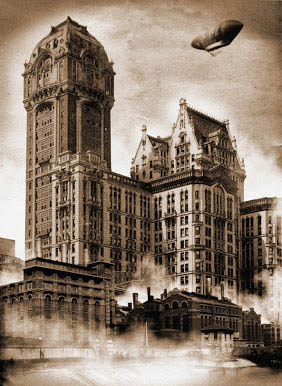East India Company
The East India Company, originally chartered as the "Governor and Company of Merchants of London trading into the East Indies", is an English mega-corporation which trades cotton, silk, indigo dye, salt, saltpeter, tea, opium and ichor with the Indian subcontinent. The Company was granted a Royal Charter by Queen Elizabeth in 1600.
Shares of the company are secretly owned by wealthy merchants and aristocrats, and the Crown owns no shares and has only indirect control. The Company rules large areas of India with its own private armies, exercising military power and assuming administrative functions.
The Indian Rebellion of 1857 significantly impacted the profit and stability of the company – even bringing the Government of India Act to a vote in 1858 – which would have essentially allowed the crown to assume control of the company. The vote failed, and the discovery of the ichor in 1872 saved the company from certain financial ruin. Now the most profitable company in the world, the East India Company enjoys a monopoly on ichor trade and some say undue influence on the Crown.
The Company's headquarters in London, from which the company and much of India is governed, is the East India House in Leadenhall Street. It was completed in 1729, and significantly expanded in 1796–1800. A new East India Clock and Steamworks Factory has been built near the docks. Opened in 1872, the Factory is strictly private and considered the most well-guarded building in England. The Company has its own police - the Security & Investigation Services - commonly called "the sisters", although most SIS operatives are men.
Major General Edward Vibart is the current Chairman of the East India Company Directors. A hero of the Indian Rebellion now in his mid-50's, the no-nonsense Vibart is the public face of the Company. He can be seen at many high society functions around London - easily spotted in his ever-present khaki military uniform. The SIS is run by a short Englishman, Mr. M, who is recognizable only because of his crimson fez hat.
The East India Club in London was formed in 1849 for officers of the Company. The Club still exists today as a private Gentlemen's club with its club house situated at 16, St. James's Square, London.
In 1803, an Act of Parliament, promoted by the East India Company, established the East India Dock Company, with the aim of establishing a new set of docks (the East India Docks) primarily for the use of ships trading with India. The existing Brunswick Dock, part of the Blackwall Yard site, became the Export Dock; while a new Import Dock was built to the north.
The East India College was founded in 1806 as a training establishment for "writers" (i.e. clerks) in the Company's service. It was initially located in Hertford Castle, but moved in 1809 to purpose-built premises at Hertford Heath, Hertfordshire.
The East India Company Military Seminary was founded in 1809 at Addiscombe, near Croydon, Surrey, to train young officers for service in the Company's armies in India. It is based in Addiscombe Place, an early 18th-century mansion.
